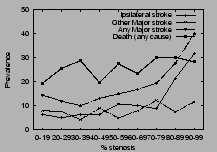 |

 |
The placebo control groups in trials looking at the benefit of anti-platelet therapy for the prevention of stroke show an overall annual risk of stroke of 4-7% per year.
Data from the ECST [Eur98] showed that the risk of major stroke (symptoms lasting longer than 7 days) in a medically treated patient with symptomatic carotid artery stenosis is about 40% when the stenosis is 90-99%, see fig 2. This estimate is based upon the actual prevalence of major stroke, and is not an actuarial estimate. Major stroke rate in medically treated patients runs at 10-20% during the study period for degrees of stenosis less than 80%. However, this rate thereafter rapidly increases to 27.7%, 44 major strokes in the 159 patients with 80-89% stenosis. The rise progresses to 40%, 24 major strokes in the 60 patients with 90-99% stenosis. An actuarial estimate of the risk of major stroke within 3 years following the transient ischaemic attack showed a major stroke rate of about 20% for a stenosis of 80-89%. This rate rises to about 30% for a stenosis of 90-99%.
Mortality is also high in patients with symptomatic carotid stenosis, about 20-30% during the ECST trial period. This mortality rate does not appear to be related to the degree of stenosis of the internal carotid artery. These data show that patients with symptomatic carotid stenosis have a high mortality, much of which is not related to stroke. Patients with stenosis greater than about 80% have a markedly increased stroke rate, with the risk of stroke rising as the severity of the stenosis increases.
In the NASCET trial [Nor91] the actuarial risk of any ipsilateral stroke in medically treated patients, with symptomatic 70-99% stenosis, was 26% at 2 years follow up. The estimate for major or fatal ipsilateral stroke was 13.1%.
| Age |
| Male sex |
| Systolic blood pressure |
| Diastolic blood pressure |
| Recency of event |
| Type of prior cerebrovascular event, stroke not transient ischaemic attack |
| Degree of stenosis |
| Presence of ulceration on the angiogram |
| History of smoking |
| History of hypertension |
| History of myocardial infarction |
| History of congestive cardiac failure |
| History of diabetes |
| History of occlusive peripheral vascular disease |
| History of high blood lipid levels |
